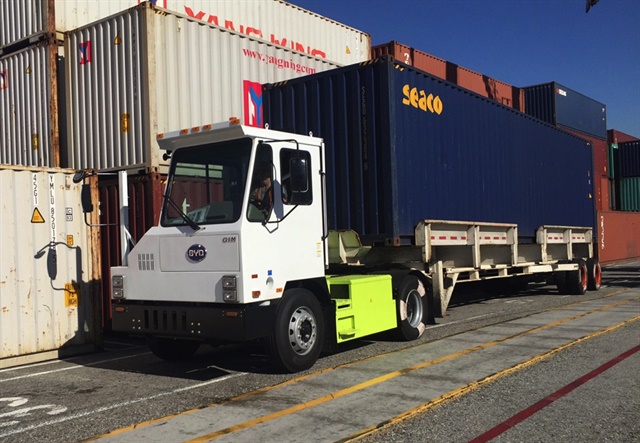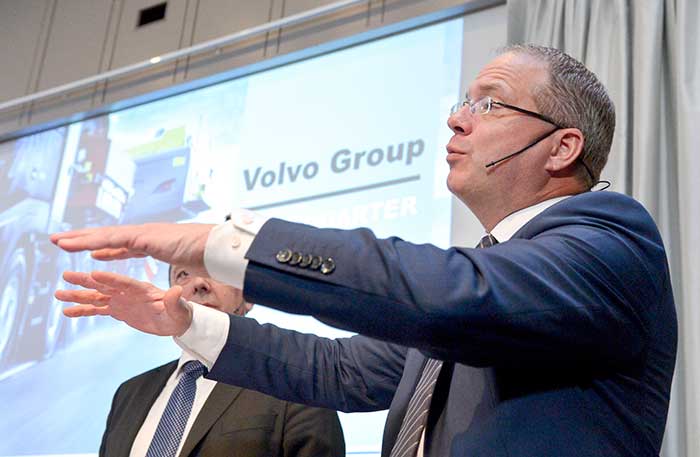
kscarbel2
Moderator-
Posts
18,863 -
Joined
-
Days Won
114
Content Type
Profiles
Forums
Gallery
Events
Blogs
BMT Wiki
Collections
Store
Everything posted by kscarbel2
-
Kenworth to display new T880S mixers at 2017 World of Concrete
kscarbel2 replied to kscarbel2's topic in Trucking News
McNeilus does offer a front discharge unit (in cooperation with Oshkosh), but the majority of what America's largest mixer body maker gets orders for are those dinosaurs you speak of. https://www.mcneiluscompanies.com/concrete-mixers/s-series-front-discharge-mixer/ -
You're right. But the government is not wasting money as far as the aristocracy is concerned. They're taking taxpayer money and redistributing it. Why does it take 5 years to upgrade a highway when it should only take one? Because there's a chain of people who profit from it. It's all an intentional waste of money.
-
In my humble opinion, the HN80 was as well engineered as the CH. I still recall when chicken producer Holly Farms took delivery of their new fleet. The HN80 only failed because Jacque Nassar mistakenly sold the heavy truck unit. The truck was superbly engineered. The HN80 caused Ford's heavy truck sales to rise over 50 percent in March 1997. Not a bad start. And in the first quarter of 1997, Ford zoomed forward, from last place in 1996, past Volvo in 1997 (Good on ya Ford). https://www.bigmacktrucks.com/topic/41662-a-look-back-at-“american”-innovation-the-ford-hn80-new-aeromax-and-louisville/#comment-302854
-
Iveco took control of Ford's European heavy truck operations in 1986 with a 52% interest. I believe the Joint venture, Iveco Ford Truck Ltd., ended in 1997 with the closure of the Langley, Berkshire, UK plant. Any non-compete wouldn't have exceeded 10 years. The Cargo technology remained Ford-owned. It's safe to say that Iveco isn't the reason that Ford doesn't make use of the global market Cargo in the US. Daimler gained North American production rights in 1997 with the Ford Truck purchase. The last year of Freightliner Cargo (FC70/FC80) and Sterling Cargo (SC7000/SC8000) sales was 2006. And that was the last generation Cargo, not today's all-new Cargo. Sadly for a company that created the superb HN80, Ford just has little interest in Class 6, 7 and 8 commercial trucks. The Class 6 F-650 only sells well because of its price, and certainly not because of an impressive sales marketing team.
-
Meanwhile back at Ford headquarters, the members of the manufacturer's commercial truck unit are fast asleep. Only the Ford-Otosan team in the global market still has blue Ford commercial truck blood flowing thru their veins. What Ford needs in the North American market is right under it's nose (Ford-Otosan designed Brazil production). http://www.fordcaminhoes.com.br/cargo/c-1419/especificacoes-tecnicas http://www.fordcaminhoes.com.br/cargo/c-1519/especificacoes-tecnicas .
-
Chevrolet Introduces 6500XD Low Cab Forward Truck Truck Trend / March 10, 2017 Standard Equipment Includes Allison Transmission, Dana Axles As part of its continuing effort to grow its commercial vehicle lineup, Chevrolet is announcing the availability of a new 6500XD model to its Low Cab Forward medium-duty lineup. The truck has a dock-height chassis, is available in eight wheelbase configurations, and can accommodate bodies up to 30 feet in length. The truck has a maximum gross vehicle weight rating (GVWR) of 25,950 pounds, a front axle rating of 12,000 pounds, and a rear axle rating of 19,000 pounds. In terms of powertrain, the 6500XD is equipped with a 5.2L I-4 turbodiesel producing 520 lb-ft of torque, mated to an Allison 2500-series six-speed automatic transmission and a Dana rear axle. For commercial customers with specific configuration needs, General Motors has a dedicated Upfitter Integration Group to serve as a liaison between Special Vehicle Manufacturers, customers, and GM’s engineering, marketing, and service teams. A website with detailed body builder manuals, technical bulletins, and best practices is also available to assist upfitting. The 6500XD will be available at Chevrolet Commercial dealers by the end of 2017. The cabover truck comes ahead of the forthcoming medium-duty conventional cab truck being codeveloped with Navistar, expected to come to market in 2018.
-
Chevrolet Expands its Low Cab Forward Range with a New Class 6 Truck Chevrolet Press Room / March 10, 2017 Chevrolet announced today that it is expanding its range of Low Cab Forward trucks with a new dock-height Class 6 model – the 6500XD. The vehicles are expected to be available by the end of the year. The 2018 Chevrolet Low Cab Forward 6500XD, like its Class 3, 4 and 5 stablemates, is a highly flexible platform designed for driver comfort, superior visibility and serviceability, and ease of upfit. The 6500XD adds significant extra capability: Standard equipment includes a 5.2-liter four-cylinder turbodiesel that delivers 520 lbs.-ft. of torque, an Allison 2500 Series 6-speed automatic transmission (with PTO), Dana axles and a robust straight-rail frame. Front and rear axle ratings are 12,000 lbs. and 19,000 lbs., respectively. Maximum GVWR is 25,950 lbs. – enough capability to haul heavy machinery. Eight wheelbases are available and bodies up to 30-feet long can be accommodated. “Our goal is to offer the best work solutions and customer care in the business,” said Ed Peper, U.S. vice president, GM Fleet and Commercial Operations. “Our Low Cab Forward dealers and Upfitter Integration Group will work hand-in-hand with customers and their upfitters to spec the right truck for the job. After the sale, our dealers will be there to support customers with extended service hours and work-ready loaners.” GM’s Upfitter Integration Group provides technical assistance to upfitters and serves as a liaison between Special Vehicle Manufacturers, end customers and several of GM’s engineering, marketing and service teams. They also maintain a website that includes detailed body builder manuals, technical bulletins and best practice manuals. GM’s Expanding Commercial Truck Portfolio GM’s overall Commercial business has been growing steadily, with seven straight months of year-over-year market share gains. “Award-winning new products like the Chevrolet Malibu, Silverado and Colorado have helped GM Fleet earn more than 134 new accounts in the last three years,” Peper said. “At the same time, new products like the City Express small van, the Low Cab Forward range and the all-new medium duty conventional cab truck coming in 2018 make it possible for fleets to consolidate more of their business with us, which simplifies vehicle ordering, financing, maintenance, technical support and turn-in.” This product offensive includes new CNG and LPG propulsion options and an industry-leading 20 diesel-powered cars, crossovers, vans and pickups, all of which are compatible with B20 biodiesel. GM is also expanding its suite of industry-leading driver connectivity and fleet management solutions for small businesses and fleet managers. At the beginning of March, the company announced that it would add Spireon to its roster of telematics service providers, joining Telogis and GM’s own Commercial Link tool. These turnkey, scalable solutions can help with efficiency, idle time, labor, fleet mileage and maintenance-related downtime. They can also help provide insights into driver behavior. Because they are compatible GM’s OnStar technology, no after-market hardware installations required. For more information about the fleet product offerings and services, please visit GMFleet.com. .
-
Heavy Duty Trucking / March 10, 2017 Chevrolet is expanding its lineup of cabover trucks for 2018 by adding the 6500XD Class 6 Low Cab Forward truck to a lineup that already includes Class 3, 4, and 5 cabovers, Chevrolet has announced. Chevrolet will source the truck through an existing partnership with Isuzu Commercial Truck of America. With the 6500XD, Chevrolet will now offer eight cabovers through select dealers, including the Chevrolet 3500, 3500HD, 4500, 4500HD, 4500XD, 5500HD, and 5500XD. Chevrolet will show the truck at the NTEA's Work Truck Show that begins March 14. The 6500XD is based on Isuzu's 2018 FTR cabover and is powered by the same 5.2L turbocharged four-cylinder diesel engine that makes 520 lb.-ft. of torque. The engine is paired with a 6-speed automatic transmission with power take-off. The truck also offers Dana axles and a straight-rail frame. Front and rear axle ratings come in at 12,000 pounds and 19,000 pounds, respectively. Maximum GVWR is 25,950 pounds. Buyers can choose from eight wheelbases and equip the truck with a body that's up to 30-feet long. "Our goal is to offer the best work solutions and customer care in the business," said Ed Peper, U.S. vice president, GM Fleet and Commercial Operations. "Our low cab forward dealers and Upfitter Integration Group will work hand-in-hand with customers and their upfitters to spec the right truck for the job. After the sale, our dealers will be there to support customers with extended service hours and work-ready loaners." Related reading - https://www.bigmacktrucks.com/topic/47238-isuzu-returns-to-us-class-6-segment-for-2018/#comment-348570 .
-
California to spend $9M on Chinese Class 5 & 8 electric trucks
kscarbel2 replied to kscarbel2's topic in Trucking News
Electric Trucks Start Arriving at Southern California Freight, Rail Yards Heavy Duty Trucking / March 10, 2017 The State of California, San Bernardino Council of Governments, and partners at Daylight Transport and BYD Motors have announced the arrival of the first of 27 zero-emission electric yard and service trucks in three disadvantaged communities in Southern California. BYD is providing the 27 vehicles, of which 23 will be battery-electric Class 8 yard trucks and four will be Class 5 service trucks. Three yard trucks and a service truck will be operated by Daylight while the other 23 trucks will operate at two BNSF Railway rail yards in San Bernardino and Los Angeles. BNSF will receive its trucks in the summer. Funded by the state’s cap-and-trade program and other programs, the demonstration truck project is part of California Climate Investments, a statewide program that invests in reducing greenhouse gas emissions, strengthening the economy and improving public health and the environment. “It’s exciting to see the first of these ultra-clean trucks roll off the manufacturing line in Lancaster and get to work moving cargo in Fontana,” said Mary D. Nichols, California Air Resources Board chair. “Electric trucks mean cleaner air for all Californians, especially those who live in neighborhoods close to freight transfer facilities and rail yards.” The two types of trucks funded by the grant are the most common vehicles at major freight locations in the U.S. and are aimed at providing a model for truck electrification that could be scaled to any facility. CalStart, a Pasadena, Calif.-based clean transportation not-for-profit, will be evaluating the future potential for commercialization and job creation. “Daylight Transport is excited to participate in the rollout of zero-emission yard trucks. We are committed to clean energy and sustainability,” said Greg Steele, Daylight Transport executive vice president. “The collaboration with CARB, SBCOG and BYD will help us toward reducing our carbon footprint and operating in a continuously more environmentally conscious manner. This is an outstanding way to introduce ourselves to the Fontana community.” DayLight Transport will operate the trucks out of a newly constructed facility that will include a 600-kilowatt solar system that covers nearly the entire 60,000-square-foot warehouse. The solar power system will be used to power the electric vehicles. The project aims to reduce emissions over the course of two years by around 2,500 tons of carbon dioxide equivalent, 3,250 pounds of nitrogen oxide, and 170 pounds of diesel soot. . -
Kenworth to display new T880S mixers at 2017 World of Concrete
kscarbel2 replied to kscarbel2's topic in Trucking News
From the standpoints of cost, design, production and maintenance, front discharge mixers are inherently a nightmare. There's nothing you can't do with rear-discharge mixers and concrete pumpers (one of the best inventions since sliced bread). -
Transport Engineer / March 9, 2017 FM Conway has revealed an £11.2 million fleet investment for 2017 – adding 17 eight-wheel and two six-wheel tippers, as well as five eight-wheel grab trucks and a new bitumen tanker to its 800-strong fleet. The infrastructure services firm is also buying two 44-tonne walking floor trailers, as well as two 18-tonne pole rigids to support its specialist lighting operations, and a CCTV equipment van for its gully cleansing division. The vast majority are based on Scania chassis. They include Scania P410CB8X4MSZ and P360CB6X4MSZ Day units with PPG ally insulated tipper bodies; Scania R450CB6X2MSZ sleeper with Martrans Ally walking floor NTTs; and Scania P410CB8X4MSZ Day cabs with plant body and crane by Charlton. Additionally, the company specified: Scania P410CB8X4MSZ Day grabs with Fruehauf bodies; Scania P410CB8X4MSZ Day dropsides with crane by Transport enterprise; and Scania P410CB8X4MSZ Day cab tippers with Fruehauf bodies. Other units include: a Scania R450LA6X2MNA Sleeper cab with Crossland bitumen tank; a Scania P410CB8X4MSZ Day volumetric mixer; a Scania P250DB4X2MNA Day cab with a Fruehauf body; and a Mercedes Benz Econic 8x4 3235L ENA grab with a Fruehauf body. FM Conway transport manager Peter Parle says the he vehicle specifications reflect FM Conway’s commitment to road safety in the construction industry. New features include an extended window in the nearside door of the eight- and six-wheel tipper trucks to improve drivers’ direct vision for vulnerable road users. “FM Conway strives to be at the forefront of road safety initiatives in the construction industry and these new vehicles have been specially designed to keep our drivers and other road users safe,” states Parle. “All of our drivers will be taking part in one-to-one training to familiarise them with the new trucks and promote safer driving.” FM Conway delivers construction and maintenance services for roads, buildings, structures and public spaces across London and the south east. .
-
Nordea: Time to buy Volvo Dagens Industri / March 9, 2017 Continued improved market outlook contributes to Nordea believes it is a good location to buy Volvo shares. It is clear from an analysis dated on Thursday, where the bank also highlights that there is scope for increased consensus estimates for Volvo, and that the share is trading at a large discount to sector colleagues. News agency Direkt reported on Thursday Nordea’s upgrade recommendation for Volvo to buy (and hold), and has raised its target price to SEK 145 (125). Nordea assumes a more positive market scenario in 2017 for Volvo Truck in Europe and North America, and Vovo Construction Equipment (VCE) in Europe and China. "After five consecutive years of sales declines, we now expect a return to growth, which should support continued margin improvement," wrote Nordea in the analysis. After the volumes within the Volvo Group total dropped by 25 percent during 2011 to 2016 (minus 18 percent for trucks and minus 45 percent for VCE) Nordea now believe that Volvo's total volumes will increase by 3 percent in 2017 and 5 percent in 2018. Nordea now expects Volvo Truck in North America to fall by 2 percent (previous forecast was a 9 percent decline). In Europe, Volvo Truck is expected to remain unchanged (previous: minus 5 percent). Volvo Construction Equipment is expected to grow by 10 percent in Europe (previously 5 percent) and by 20 percent in China (previously 10 percent). The bank points out that the growth forecast for the Volvo is back-loaded than in 2017, primarily as a result of the trucks in North America is expected to return to growth in the second half of the year. .
-
He has lifted the Volvo with 62 billion Magnus Alfredsson, Private Affairs SE / March 9, 2017 Martin Lundstedt was hired as a savior for Volvo for just under a year and a half after the former CEO was fired. And since then, the reports have become increasingly better and the market has shown their appreciation - including dividends, the value increased by more than 62 billion. For several years, the analysts of the stock market highlighted the Volvo as the company that had the best chance among the larger companies to speed up the course. But time after time, Volvo has made the market disappointed with poor results - and hopes of a boost has been constantly postponed. Why did former CEO Olof Persson fired in 2015 and Volvo's Board of Directors made the unusual grip hiring former CEO of Scania Martin Lundstedt. Scania has historically been clearly more profitable than the Volvo and are often regarded as more innovative and had the lead in the development of new truck models. So it's easy to see why Lundstedt could redeem Volvo from slumber if he could transfer some of what has been good at Scania to Volvo. And slowly but surely, he has managed to convince the stock market that the company is on the right track - and the best way is to surprise at the reports and there has also been a number of occasions. Therefore passed share level $100 in November last year and since then the trend has been strong, with a further 20 percent rise. And on Thursday, when the stock ends at the level of just under SEK 124 is the highest figure in a decade - and in addition, Volvo has passed the course level when the stock market was high in April for two years ince. It is slightly higher than in the accounts for just over a month ago and the course has recently been pushed up by expectations around the construction equipment operations in the business area VCE. First, weak demand for a long time now turned up - not least in China, where the total increase for the movers in February are several hundred percent up. In addition there since ancient speculation that Volvo will spin off VCE in any form - and spin-offs is something the stock market in general always like. That 1 + 1 equals more than 2 is an old truth that repeatedly actually proves correct. Next in line for the Volvo public's Annual General Meeting on April 4 where Martin Lundstedt will speak before a gathering satisfied shareholders - for once. The meeting will decide on increasing the dividend by 8 percent to SEK 3.25 is also a factor that allows new year high may be imminent. Private Trades speculated at the level of SEK 119 at year-end that the shares could have 5-10 percent of potential left in the near term. But with a better profitability for VCE already this year there may be an almost cautious assessment. We are also supported by an analysis of Nordea on Thursday that put the purchase of Volvo and which raises the target price to SEK 145 (125). The reason is that the brighter market prospects will enhance forecasts of market analysts plus Volvo shares are traded - despite its nice rise - at a discount to its sector peers. .
-
Dagens Industri / March 9, 2017 Industrial Group Volvo shares are up at the highest level in almost ten years. But the stock has more to give? This week, Volvo's stock price blew through the Volvo 122-kronor barrier, which means that the shares are traded at the highest level in almost ten years. On Thursday, shares continue up by just under 1 percent, including when Nordea raised its recommendation for the shares to purchase, and in a year it has risen by over 40 percent. But shares can still rise more. "I believe that the shares are worth buying even at these levels," says Hampus Engellau, analyst at Handelsbanken. Engineering sector is generally good on the Stockholm Stock Exchange, but in addition there are several reasons in addition to the right to Volvo's share going strong. "Profitability in the trucks, which is the crux of the company, has now risen for eight consecutive quarters compared with the previous year," says Hampus Engellau. Meanwhile, savings programs initiated by Volvo’s previous CEO Olof Persson are now being realized. But current CEO Martin Lundstedt, who took office in October 2015, has also worked hard to Volvo to deliver shareholder value. When he took office, there was talk that he would "Scanify" Volvo (Martin Lundstedt previously was the CEO of competitor Scania), that is more focus on customers, cost control and productivity improvements. "That sounds a little like consulting snack but when you talk to people in the organization, it really feels like he had with the people on the train, and that the units of the Volvo become more independent and entrepreneurial," says Hampus Engellau. "All these measures have led to earnings improvements and it is reflected in the valuation of the shares. Volvo's profitability is almost as high as Paccar." The stock market has speculated on whether Volvo’s construction equipment business, VCE, will be spun off and distributed to the shareholders, a business with a turnover of just under 50 billion. A measure that fueled the speculation is that VCE's headquarters was relocated back to Gothenburg while the business gradually started to separate from the rest of the group. Factors that pushed the Volvo share price in recent days isn’t just about VCE. The week, statistics from China showed that its excavators sales there rose 300 percent in February compared with the same month last year. According to an analysis by Nordea, Volvo excavator sales rose faster than the overall market with a growth of over 500 percent compared to February last year. Hampus Engellau would welcome a merger of VCE and Atlas Copco's mining operations, which Di earlier reported , although he believes that the synergies between the companies is limited. "However, it is a merger that probably would be relatively simple and easy to do." Such bundling would create a new workshop sixth with just over 80 billion in sales. "The company would be quite like Caterpillar and Caterpillar valued at P / E of 30," says Hampus Engellau. .
-
Scania Group Press Release / March 9, 2017 Scania’s low-emission engines will be used in airport rescue and firefighting vehicles at airports in the US. Scania will deliver 24 16-litre V8 engines for use in Oshkosh Airport Products’ airport rescue and firefighting (ARFF) vehicles Striker 6×6 and Striker 4×4. The engines are optimized for the Oshkosh powertrain, and each complies with Tier 4 final emission legislation. The ARFF vehicles will be put into service at John F. Kennedy International Airport, Newark International Airport, LaGuardia International Airport and Teterboro Airport, which are located in New York and New Jersey. Art Schuchert, Sales & Marketing Director for Scania USA, is keenly anticipating the two companies’ collaboration on this deal, which he believes marks the start of a new journey in the partnership with Oshkosh. “This project is important for Scania and will take us into the serial production of the prestigious Striker vehicles,” he says. For Oshkosh, the reason for choosing Scania is clear, as Jeff Resch, Vice President and General Manager of Oshkosh Airport Products, explains: “Scania has a reputation for industry-leading quality, performance and service, which is why it makes so much sense to incorporate their engines into all Striker configurations.” Rikard Mattsson is Area Manager at Scania Engines, with responsibility for the cooperation between Scania and Oshkosh: “We are looking forward to our engines providing Oshkosh products the best possible performance and reliability, all backed up by our growing service network in North America,” he says. .
-
Western Star 4900s recalled over service brake issue
kscarbel2 replied to kscarbel2's topic in Trucking News
Brake issue prompts recall of 450 Western Star 4900 trucks Overdrive / March 9, 2017 A problem with the service brakes on approximately 450 Western Star trucks has prompted Daimler Trucks North America to issue a recall. The recall affects 2015-2018 Western Star 4900 trucks manufactured between March 3, 2014, and Jan. 31, 2017, that were built with certain triple compartment aluminum air tanks. The company says these tanks could experience weld separation. If weld separation occurred in these trucks, it could cause “a rapid loss of air pressure without warning,” which could cause the sudden application of the park brakes, increasing the risk of a crash. Daimler says it will notify owners, and dealers will replace the aluminum air tanks with steel, triple compartment air tanks for free. The recall is expected to begin April 27. The National Highway Traffic Safety Administration’s recall number for this recall is 17V-124. -
Heavy Duty Trucking / March 9, 2017 Volvo Trucks North America (VTNA) has added new safety and performance features for the Volvo I-Shift for Severe Duty and I-Shift with Crawler gears automated manual transmissions. A new Auto Neutral feature was added to improve jobsite safety while a Paver Assist feature bolsters the Volvo VHD’s performance in paving applications. Auto Neutral reduces the possibility of a truck moving as a result of inadvertent throttle application by placing the I-Shift transmission into neutral when the parking brake is set. When the parking brake is released, the transmission can be shifted back into drive to go back into gear. The feature is aimed at trucks in many applications, including concrete mixers, where remote throttle is often used. Auto Neutral will be available for order in the second quarter of 2017 for trucks equipped with Volvo GHG 2017 engines and the latest generation Volvo I-Shift. For trucks already in service, it can be activated with the Volvo Premium Tech Tool. Paver Assist for the I-Shift on Volvo VHD model dump trucks helps eliminate bumps and disturbances in the pavement laying process that can occur when shifting from neutral to drive. Truck operators can shift into drive without first applying the brakes when shifting from neutral and being pushed by a paver to driving operations and pulling away from the paver equipment. To use the feature, a driver shifts from neutral to drive while rolling very slowly and depressing the “+” button on the I-Shift shifter. Paver Assist is also useful for other low-speed applications when a vehicle needs to drive away without applying brakes. The feature is currently available on Volvo VHD models equipped with Volvo GHG 2017 engines and the latest generation I-Shift transmission. Paver Assist can be activated using the Volvo Premium Tech Tool. The Volvo VHD comes standard with a 12-speed I-Shift for Severe Duty, featuring hardened gears and other hardware to help withstand frequent shifting in rugged operating environments. The I-Shift with Crawler Gears is available in 13- and 14-speed versions. The 13-speed I-Shift with Crawler Gears helps provide improved startability on steep grades, soft terrain, or when the truck is under heavy load. The 14-speed variant is made for applications such as concrete pouring that require low-speed maneuverability.
-
ConMet Partners on In-Wheel Electric Drive Heavy Duty Trucking / March 9, 2017 ConMet and Protean Electric have formed a partnership to develop an electric in-wheel drive system as a hybrid-electric solution for medium- and heavy-duty commercial vehicles. ConMet will combine its experience with commercial vehicle wheel ends with Protean Electrics’ in-wheel electric drive. Protean’s system is self-contained within each wheel without a need for gearing, driveshafts, or differentials powering each individually to provide a fuel economy boost to the vehicle. The system also stores regenerative braking energy, which allows it to have a smaller battery. “This agreement enables us to expand the market reach of our ProteanDrive technology into the commercial vehicle market," said Andrew Whitehead, chief commercial officer at Protean Electric. "ConMet has the commercial vehicle market and wheel hub experience we have been looking for to help develop this solution." The ConMet/Protean in-wheel electric drive system will be designed for commercial trucks, tractors, and trailers. The jointly developed electric wheel end system, which is compatible with existing vehicles, is aimed at providing vehicle packaging advantages, reducing complexity, and minimizing drivetrain losses for commercial vehicle and trailer applications. “We are combining our decades' long expertise in wheel hubs for commercial vehicles with Protean Electric's success with drive systems for electrified passenger vehicles," stated Beto Dantas, ConMet vice president of marketing, innovation, and strategy. "The result is the development of an innovative wheel end product that will provide lower lifecycle costs, improved fuel economy, added torque, increased power, and better overall vehicle performance."
BigMackTrucks.com
BigMackTrucks.com is a support forum for antique, classic and modern Mack Trucks! The forum is owned and maintained by Watt's Truck Center, Inc. an independent, full service Mack dealer. The forums are not affiliated with Mack Trucks, Inc.
Our Vendors and Advertisers
Thank you for your support!








